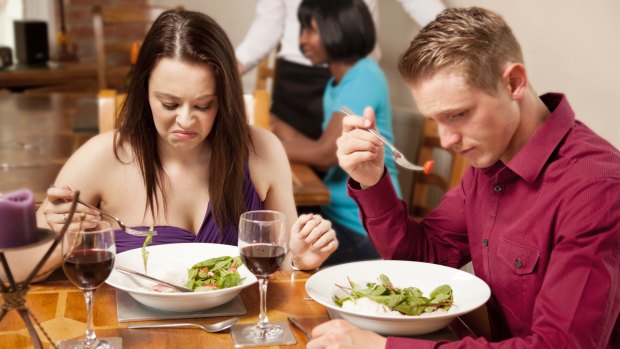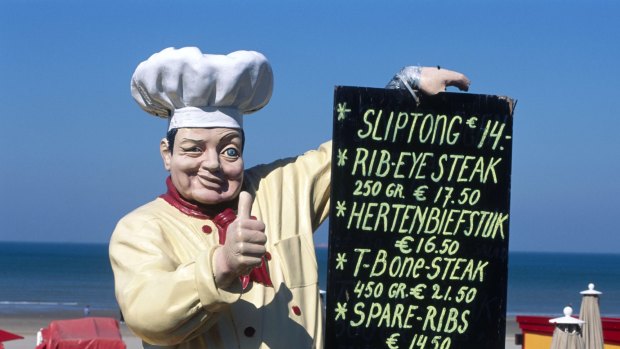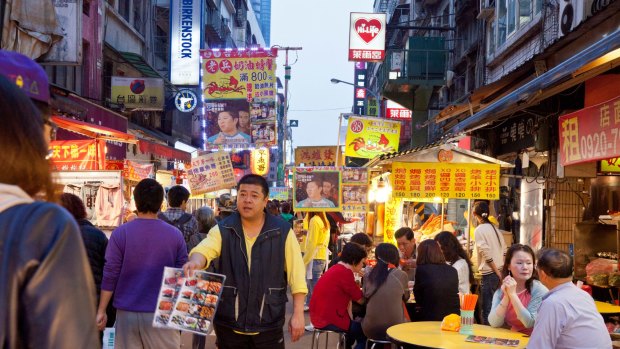This was published 7 years ago
How to find a good restaurant when you're travelling: The 10 signs of a terrible restaurant

Read the warning signs and you can avoid a bad restaurant meal.Credit: iStock
Eating well on the road may be something of a lottery without prior research. The restaurant you wander into on a whim may be great, and may be awful. It is, alas, difficult to identify the former on sight. But you can read the warning signs about the latter and steer well clear…
Pictures of the food
The all-time classic sign of a bad restaurant is feeling the need to put pictures of the food all over the menu. And always bad, slightly sad, faded pictures too – ones that look like they were shot in the resolution that 1980s American TV sitcoms were filmed in. Obviously, if the pictures have broken free from the menu, and are lining the windows as well, then you can be absolutely certain of a dire feed.
Pictures of a loveable cartoon chef
These generally take the shape of a fibreglass figure or near lifesize cardboard cut-out standing outside the restaurant. The chef will have a moustache and big white chef's hat, and will be probably holding out some sort of tray as if the person who created it doesn't understand the difference between a chef and a waiter. You will never find a good restaurant that has one of these monstrosities outside.

Thumbs down to loveable cartoon chefs.Credit: Alamy
It is a 'family' restaurant
This applies first and foremost to ones that bill themselves as family-friendly. They're already marking their USP out as being accommodating to children, rather than having good food. The two aren't mutually exclusive, of course, but that tends to be the case with those conspicuously advertising the former.
The second sort of family restaurant is the one that makes a big play of being family-owned and run. These can be OK, but you can bet that the more they push the family angle, the worse the food is.
Touts
If there's someone outside collaring passers-by in order to get them to go into the restaurant, you take that as a sure sign that locals have already made their decision on the place. Touting reeks of desperation, and justifiable lack of confidence in the culinary offerings.

Not a good sign: Touts.Credit: Alamy
It's near a train station
Generally, any restaurant within 300 metres of a major train station is catering to people who want something – anything - to eat, and want it in a hurry. Said joints are generally not counting on people coming back for more...
It's within sight of a major tourist attraction
If you can see the Eiffel Tower from there, or it's on the main square, you can reliably expect prices to be significantly jacked up and the food to be mediocre at best. Head a street or two down, to the point where you can't see the thing everyone's come to see, and the food may still be mediocre – but it probably won't cost as much.
Doubled up cuisine
Fusion cuisine can often be ace. But simply serving two types of cuisine? Less so. Basically, anywhere that bills itself as Italian-Mexican or Thai-Japanese is lazily trying to cover two bases because it knows it doesn't do either of them well enough. Use the same principles you'd apply to a fast food joint that does pizzas… and kebabs… and burgers… and fried chicken.
Multi-language menus
There's a fine line between being accommodating and being desperate. There's reasonable logic for a menu in Prague to be translated into German and English, for example. One's the major language of neighbouring countries, and the other is the nigh-on global lingua franca. But if there are also translations in Russian, Chinese, Spanish, Italian and Portuguese, then it's usually a sign of a place going whole hog for undemanding tourists.
"Popular with groups"
The Google Maps app is brilliant for finding nearby restaurants. And most of the short descriptions on it are useful, describing the cuisine, calling it cosy, having great cocktails etc. But "popular with groups" comes up an awful lot, and that seems to be shorthand for "there's absolutely nothing else notable or positive we could say about this place". This is a theory that tends to tally with the ratings given by previous diners, too.
The online review score is bad
The likes of Tripadvisor, Google Reviews and Yelp are not entirely reliable for picking a great restaurant. They all lean to the conservative side of things – so those that do something really different, really well will often get marked down by virtue of not being to everyone's taste. The top ten lists can be taken with a pinch of salt – it's likely that better places have missed the cut through how the system works.
What you rarely get, however, is bad restaurants with unusually high scores. Generally, it it's above four out of five, it's a pretty good option. Anything below 3.5? Forget about it.
See also: The best country in the world for food
Sign up for the Traveller Deals newsletter
Get exclusive travel deals delivered straight to your inbox. Sign up now.